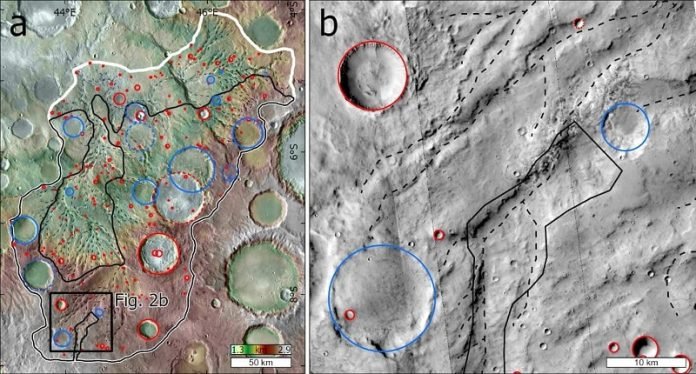
Once upon a time, Mars, now a vast red desert, was home to flowing rivers and valleys, much like Earth.
Understanding how these Martian valleys formed is like putting together a giant cosmic puzzle, with implications for life on early Mars.
Alexander Morgan, a scientist at the Planetary Science Institute, has added an important piece to this puzzle, revealing new insights into the history of water on Mars.
Morgan’s study, titled “New maximum constraints on the era of Martian valley network formation” and published in Earth and Planetary Science Letters, takes a closer look at the Martian surface.
More than 3 billion years ago, Mars had valley networks shaped by running water, much like river valleys on Earth. These valleys are crucial evidence of Mars’ watery past.
The big question has always been: How long did it take for these valleys to form? Earlier research showed that it took at least tens of thousands of years to carve out these valleys.
However, no one knew the maximum time these valleys took to form. That’s where Morgan’s research comes in.
Using impact craters as a dating tool, Morgan was able to estimate the maximum time it took for these Martian valleys to form.
He examined craters that were older and younger than the valleys. By doing this, he set a time limit of hundreds of millions of years for the formation of these valleys.
What does this mean? It suggests that the conditions allowing rivers to exist on Mars were not constant. Instead, they came and went over time.
Imagine Mars having long, dry periods with occasional bursts of river-forming activity. This intermittent pattern indicates that Mars’ climate was complex and ever-changing, much like Earth’s climate history.
The study of Mars’ past has often been oversimplified into two theories: either Mars was “warm and wet” with oceans or “cold and icy” with massive ice sheets.
Morgan’s research, however, shows that Mars’ climate history cannot be summed up in just a few words. Like Earth, Mars experienced significant climatic shifts over millions of years.
Morgan compares the slow erosion of Mars’ valleys to the Atacama Desert on Earth, known for its slow erosion rates. This similarity hints at two possibilities.
First, erosion on Mars might have been slow because of large boulders in the riverbeds.
Second, Martian rivers might have flowed very infrequently, perhaps as little as 0.001% of the time. This sporadic flow suggests that Martian rivers were generally dry, becoming active only under certain conditions like volcanic activity or changes in Mars’ tilt and orbit.
These changes in orbit and tilt, known as Milankovitch cycles on Earth, are also responsible for Earth’s ice ages. On Earth, these cycles affect river flow over long periods, as seen in the large lakes and rivers that existed 20,000 years ago in what is now Nevada. Morgan proposes that Martian rivers operated similarly, with short-term changes due to weather and long-term changes driven by the planet’s spin and orbit.
Morgan’s work paints a picture of a Mars that was once home to flowing rivers, shaped by a climate that fluctuated over millions of years.
This research not only provides a deeper understanding of Mars’ past but also offers clues about the planet’s potential to support life during its early history.



